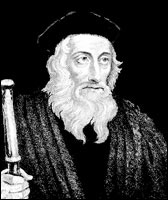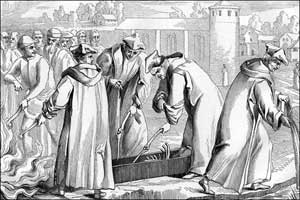DURING THE GREAT WESTERN SCHISM, THE PONTIFFS AT ROMA INSISTED THAT ONLY
POPES WHO RESIDED IN ROMA WERE GENUINE SUCCESSORS OF SAINT PETER!! |
After Catherine of Siena dragged Pope Gregory back to Roma, dissension set in immediately between the English, French, and Spanish factions who controlled the Papacy.
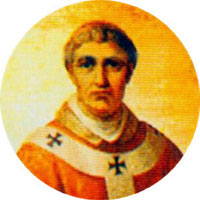 Pope Urban VI (1318–1389). Pope from 1378 to 1389. |
|
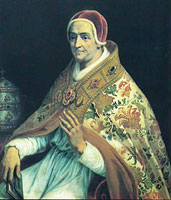 Avignon Pope Clement VII (1342–1394). Avignon Pope from 1378 to 1394. |
With 2 Popes anathematizing each other, it was an "open door" for the Christians in Britannia to preach the true Gospel, and expose the 7,000 deadly sins of the Latin clergy. Foremost among the Reformers was Saint John Wycliffe—a professor at Oxford University.
His translation caused a sensation in England and it looked like the break with the Papacy was imminent. Wycliffe had a Judas assistant named John Purvey (1354–1414). Purvey poisoned the Saint and after his death he edited his translation to conform to Jerome's perversion. Wycliffe was the last person to correctly translate the Bible. Most of the corrupt readings of the modern Bibles conform to Jerome's version (St. John 7:8).
After his death, the monks left no stone unturned in their search for copies of Wycliffe's English translation. Any copies found were promptly burned (with the owners)! At that time England was also experiencing a titanic struggle for supremacy between English and French. Wycliffe's translation tipped the scales in favor of English, so he can rightly o be called the "Father of the English Language."
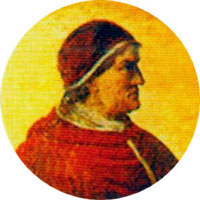 Pope Boniface IX (1350–1404). Pope from Nov. 1389 to 1404. |
|
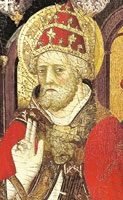 Avignon Pope Benedict XIII Pope from 1394 to 1423. |
At that late date, Pedro was still determined to fulfill the "prophecy" of Joachim of Fiore. Pedro was a canon lawyer by profession and not even a priest. He quickly found a cardinal to ordain him a priest, and bishop, after he became Pope.
Pope Benedict XIII was recognized as the legitimate Pope by the following countries: France, Scotland, Castile, Aragon, Navarre and Portugal. His predecessor, Pope Clement VII, had just met a timely death, so Pedro promised to resign immediately after his crowning . . . if his counterpart Pope Boniface IX, also resigned.
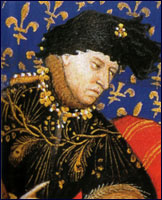 King Charles VI (1368–1422). King from 1380 to 1422. |
|
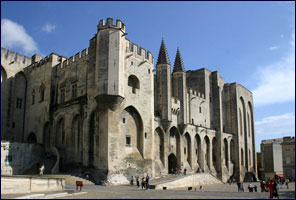 The massive Palace withstood a 4.5 year siege. |
Pope Boniface IX was sent to St. Peter in 1404, and he was succeeded by Pope Innocent VII.
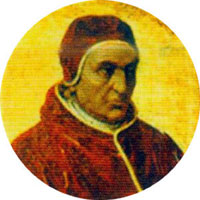 Pope "Innocent" VII. Pope from 1404 to 1406. |
|
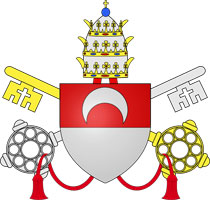 Pope Benedict's coat of arms with the Muslim crescent moon. |
Normally the French supported any of the Avignon Popes, but since Pedro was a Spaniard, their attitude toward him changed completely. The king sent one of his top generals, Marshal Boucicault, who boasted that within days he would be bringing Benedict back to Paris in chains. The siege began on September 22, 1398:
Boucicault led his troops into Avignon on September 22, 1398, and took over the city, replacing Cardinal Jean de Neufchâtel and proving to the citizens that they had not bought peace by turning coats. His men seized the house of Cardinal Pérez, one of Benedict's loyal five. (Gail, The Three Popes, p. 129).
The garrison of the Vicar of the "Prince of Peace," augmented by his Spanish Knights Templar, made a ferocious defense of the Palace. By the middle of November, Marshall Boucicault was relieved of his command and replaced with Georges de Marle, Seneschal of Provence. He had no better success that his predecessor.
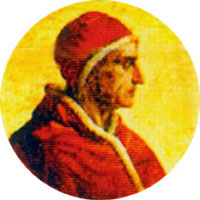 Pope Gregory XII (1326–1417. Pope from 1406 to 1415. |
|
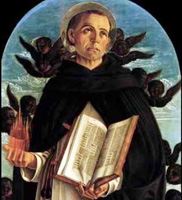 Dominican friar Vincent Ferrer (1350–1419). |
At the same time as the 2 pontiffs competed at Roma and Avignon, a third Papacy was established at the Italian city of Pisa (home of the famous leaning tower). The duo are called the Pisans Popes.
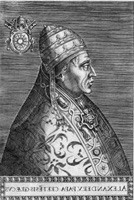 Pisan Pope Alexander V. Pope from 1409 to 1410. |
|
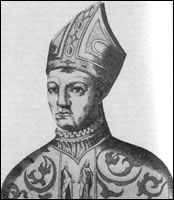 Pisan Pope John XXIII (1370–1419). Pope from 1410 to 1415. |
With 3 pontiffs competing bitterly for the "Chair of St. Peter," it was a golden opportunity for the Terrible Turks, who were already pressing on the Eastern frontiers of Western Europe.
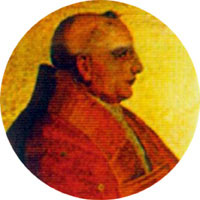 Pope Martin V (1369–1431). Pope from 1417 to 1431. |
|
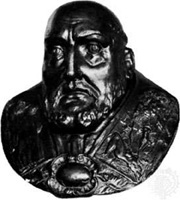 Pope Clement VIII. Pope from 1423 to 1429. |
From that time onward the Spanish hierarchy never accepted the Popes at Roma as the legitimate successors of St. Peter.
The Lunatic dynasty was continued by the Jesuits!
It is quite possible that the Borgias and Ignatius Loyola were descendants of Pope Benedict XIII. The papal dynasty has always elected "nephews." which is a euphemism for "son."
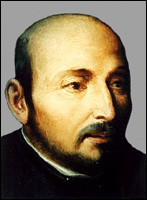 Ignatius Loyola (1491–1556). Black Pope from 1541 to 1556. |
|
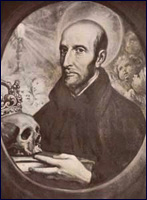 Francis Borgia (1510–1572). Jesuit general from 1565 to 1572 |
By creating a shadow or parallel Papacy, the Spanish cardinals were able to perpetuate the dynasty started by Benedict XIII in 1394.
Since the official founding of the Jesuits by Pope Paul III in 1540, there has been a total of 47 White Popes.
Since the official founding of the Jesuits in 1540, there has been a total of 31 Black Popes.
